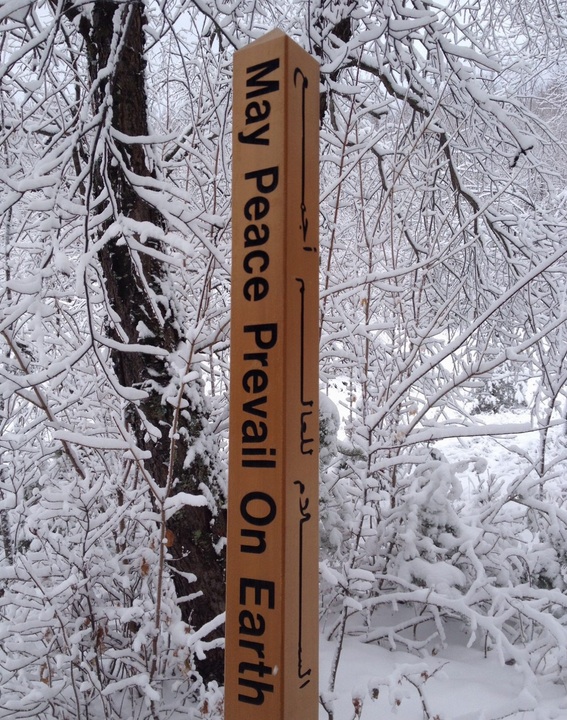Mary Hudson, pagan chaplain at Hendricks Chapel, Syracuse University, spoke about the pagan student group on campus and their project of installing a peace pole there.
She explained that she is one of 10 chaplains at Hendricks; she works with a student Interfaith Council involving five world traditions established to bring more spirituality to campus. Mary took over as advisor to the group from Tiffany Steinwert, former Dean of Hendricks Chapel. The members of this student group are all volunteers, meet once a month, take turns facilitating the meetings, and choose the direction for the organization. Mary asked them to develop a mission/vision statement, and to determine a focus the next academic year. In addition, a five-member steering committee was developed. The spirit of the group is egalitarian, and Mary’s function now is mainly to take notes and to seek resources from the Hendricks Chapel Dean.
In the second semester of Mary’s involvement with this group, the students decided to get to know one another, and in the third semester, they chose to understand better the different faiths involved. Now they are in the fourth semester, and the students are attending one another’s rituals and the activities in the various faith groups, taking ideas back to their own groups. Five students will be going to Washington for a national conference. And on September 25, they are participating in a panel discussion on campus – addressing the topic ‘being spiritual on campus.’ In addition, they make sandwiches for the homeless, each group contributing ingredients – which include hallal and kosher options.
One large project they decided on last spring involved planting a peace pole. The students raised approximately $1200 from their own groups – with some seniors donating $60 each.
Mary explained the history of peace poles. To promote peace in the world, a Mr. Masahisa Goi – inspired by World War II – developed the idea of poles carrying the words ‘may peace prevail on earth.’ In Japan, peace poles are ubiquitous. The first peace pole in America was erected in 1986. Now they appear in almost every country. Mary estimated that they number around 250,000.
There are a few in Syracuse – at Plymouth Church, All Saints Church, and May Memorial at least.
They can be made of wood or metal; the SU students chose a tall one (approximately six and a half feet tall), made of cedar, with six sides. It will be engraved with the peace message in 12 languages – six on top, the other six beneath. The languages will be English, Onondaga, Arabic, Hebrew, Chinese, German, Hindi, Korean, French, Spanish, Portuguese, and Turkish – the last ten based on the student demographics on campus. It will be installed next to Hendricks Chapel.
In addition, the Chancellor’s Cabinet liked this idea so much that they are funding a second pole, to include other languages and thus to include all students on campus. And SU will pay for planting the poles. The poles are ordered from PeacePoles.com in Michigan, where the carving is done. Swahili, Ebo, and Gaelic will be represented, and the students will pick the next nine languages. One WTB member raised the possibility of Braille being included on the lower part of the pole. A representation from the UN wants to come to the planting ceremony.
Mary then spoke about Paganism, explaining which groups do and do not fall within the pagan tradition. For instance, Romani (gypsies) do fall under Paganism, while Hindu, Native American traditions, Shinto, Buddhism, and Satanism all do not. Mary explained that no chaplain is an employee of the university, but there are requirements for a chaplain to be on campus. A church group sponsors the chaplain. Among the various pagan faith traditions, Mary is a druid but is sponsored by the Church of the Greenwood, which is nondenominational. She attained high priestess status after a four-year process.
She explained that pagans have no church buildings; they conduct rites outside except for potentially dangerous weather conditions. The next big pagan holiday will be Samhain, on October 31s, to honor ancestors. This is the most solemn of the pagan holidays. Names are read of those who have died, that one wishes to honor; these individuals are thanked for having been alive, for if they had not been, then the worshiper would not be. Visitors are welcome to attend the pagan holiday ceremonies.
At Yuletime, the longest night of the year, pagans hold a 15-hour vigil from sunset to sunrise, tending a fire outside all night. Some of the pagan worship sites, such as St. Michael’s Tower in Glastonbury, England, seem to have strong energy fields. Mary explained that Central New York has good energy fields as well, perhaps accounting for the high preponderance of pagans here – more so than in other areas.
In closing, Mary invited all attendees to join in forming a circle of peace and friendship.

